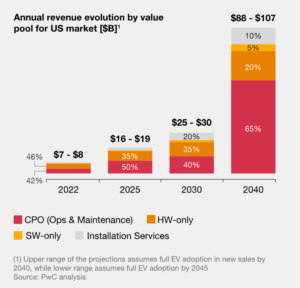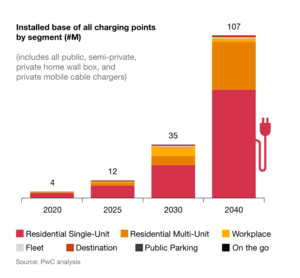If you currently drive a gas-powered vehicle, you are supported by an estimated 135,000 outlets with over 1.4 million pumps. Accessibility, efficiency, convenience and capacity work together in balance to drive competitive options with virtually no wait. The emerging network of EV charging stations will have to follow suit to support the growth of the EV market and reduce fear of range anxiety.
Talking about the growth of the EV market, a PricewaterhouseCoopers analysis shows the number of EVs in the US is estimated to hit 27 million by 2030 and 92 million by 2040 – with the number of charge points in the US growing from about 4 million today to an estimated 35 million in 2030.
As the EV infrastructure market grows (projected to grow by approximately $100B by 2040), there are four main value pools that will stand to benefit the most – hardware, software, installers and charge point operators (CPOs build, operate and maintain EV charging stations) with CPOs accounting for more than half of the total market.

While residential charging has been the predominant segment focus in the past, the shift to at-work charging is on the rise. In fact, it will account for about 17% of the entire charging market by 2030. This shift is especially important to engineering and construction firms who will be expected to incorporate charging points into the design of new buildings or retrofit existing infrastructure for their clients.

If you haven’t already considered where your business fits into the growing EV infrastructure market – there is no better time than the present. We have assembled a knowledgeable team that can step in at any stage of the EV lifecycle to help you achieve your changing infrastructure goals.
All statistics in this blog post were sourced from PricewaterhouseCoopers (PwC).


